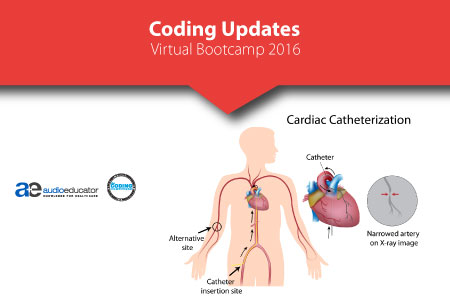Cardiac catheterization has a number of uses, from diagnosing coronary artery disease, valvular heart disease, to angina (chest pain), congestive heart failure and certain congenital heart conditions. Cardiac catheterization involves the insertion of a small, flexible tube (catheter) in a blood vessel in the patient’s arm, groin, or neck and further through the aorta into the various parts of the heart or coronary arteries. The injection of a contrast dye through the catheter is then used to look for blockages in the arteries, a procedure called coronary angiography.
Proper cardiac catheterization coding, cath lab coding and cardiology diagnostic coding is essential to get proper reimbursement. Cardiac catheterization is a diagnostic medical procedure, and includes the introduction of the catheter, positioning and repositioning of the catheter, recording of intracardiac or intravascular pressure, the final evaluation and report.
Coding for Cardiac Catheterization
- 93451 Right heart catheterization including measurement(s) of oxygen saturation and cardiac output, when performed
- Right heart catheterization includes catheter placement in one or more right cardiac chambers, obtaining blood samples for blood gas measurement and cardiac output measurement (Fick or other method).
- 93452 Left heart catheterization including intraprocedural injection(s) for left ventriculography, imaging supervision and interpretation, when performed
- Left heart catheterization includes vascular access, catheter placement in left-sided (systemic) cardiac chamber, sedation and monitoring, measurement of pressures, removal of catheters, left ventriculography, coronary angiography, closure device angiography, closure device deployment and report generation.
- 93454 Catheter placement in coronary artery(s) for coronary angiography, including intraprocedural injection(s) for coronary angiography, imaging supervision and interpretation
- 93455 Catheter placement in coronary artery(s) for coronary angiography, including intraprocedural injection(s) for coronary angiography, imaging supervision and interpretation; with catheter placement(s) in bypass graft(s) (internal mammary, free arterial, venous grafts) including intraprocedural injection(s) for bypass graft angiography
- 93457 Catheter placement in coronary artery(s) for coronary angiography, including intraprocedural injection(s) for coronary angiography, imaging supervision and interpretation; with catheter placement(s) in bypass graft(s) (internal mammary, free arterial, venous grafts) including intraprocedural injection(s) for bypass graft angiography and right heart catheterization
- 93459 Catheter placement in coronary artery(s) for coronary angiography, including intraprocedural injection(s) for coronary angiography, imaging supervision and interpretation; with left heart catheterization including intraprocedural injection(s) for left ventriculography, when performed, catheter placement(s) in bypass graft(s) (internal mammary, free arterial, venous grafts) with bypass graft angiography
- 93461 Catheter placement in coronary artery(s) for coronary angiography, including intraprocedural injection(s) for coronary angiography, imaging supervision and interpretation; with right and left heart catheterization including intraprocedural injection(s) for left ventriculography, when performed, catheter placement(s) in bypass graft(s) (internal mammary, free arterial, venous grafts) with bypass graft angiography
Coding for Diagnostic Coronary Angiography
Understanding cardiology diagnostic coding is essential for getting proper reimbursement and for remaining in compliance. CPT® guidelines for 92920-92944, represent percutaneous revascularization services for coronary vessels, and state “Diagnostic coronary angiography may be reported separately under specific circumstances.”
These mention the specific circumstances when diagnostic services can be reported separately. Some instances when diagnostic service may be separately reported from intervention performed at the same session are:
- The absence of previous coronary angiography catheter based study of patient, leading to physician performing full diagnostic study, and performing intervention based on that study. Here the diagnostic service can be reported in addition to the same-session intervention.
- If changes to the patient’s condition in a clinically relevant way before the procedure, mean the previous study doesn’t provide adequate visualization of the area, or, during the procedure, the physician determines that the patient needs a study performed outside the target area.
Add-on Procedures with Cardiac Catheter Placement
Suparavalvular aortography: +93567 Injection procedure during cardiac catheterization including imaging supervision, interpretation, and report
Use this code to list supravalvular aortography separately in addition to code for primary procedure. The code describes positioning a catheter in the aortic root and injecting contrast. The resulting angiograms show the aortic valve, the aortic root, and the ascending aorta.
Pulmonary angiography: +93568 Injection procedure during cardiac catheterization including imaging supervision, interpretation, and report
Use this code to list pulmonary angiography separately in addition to code for primary procedure. The code describes passing a catheter through the right atrium into the right ventricle, and then into the main pulmonary artery or one of its branches. Report this add-on code in addition to 93451, 93453, 93456, 93457, 93460, 93461, and CHD heart catheterization codes.
To know more about cardiology diagnostic coding, cath lab coding, correct coding for cardiac caths including injections, and S&I and graft injections, check out the virtual coding bootcamp with expert Terry Fletcher, ICD-10-CM: CPC, CCC, CEMC, SCP-CA, ACS-CA, CCS-P, CCS, CMSCS, CMCS, CMC. She will discuss cath and interventions performed at the same encounter, and the modifier impact on reimbursement, as well as coding for multiple vessels and arteries during the same session. She will also discuss correct and compliance coding of EKG’s, holters, event monitors, echos, nuclear medicine and more for in office diagnostics and cath lab “extras” such as thrombectomies, adenosine challenges, and aortography.




